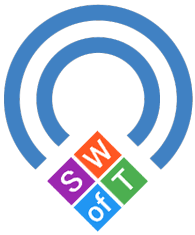
Selected for the Google Internet of Things (IoT) Technology Research Award in March 2016
Google provided IoT technology prototypes and support for developing the project

Physical Semantic Web
Semantic Web technologies have been acknowledged as tools to promote interoperability and intelligent information processing in ubiquitous computing.
The Semantic Web and the Internet of Things paradigms are even more converging toward the so-called Semantic Web of Things (SWoT)
[1] enabling semantic-enhanced pervasive computing by embedding intelligence into ordinary objects and environments through a large number
of heterogeneous micro-devices, each conveying a small amount of information.
The proposed project aims to demonstrate how encapsulate semantic annotations in beacons, to enhance features and functionalities offered by objects
in a Physical Web. Reference scenarios could be so extended to enable both human-to-machine and machine-to-machine interactions:
objects become resources exposing a semantic annotation used to characterize themselves without depending on a centralized infrastructure.
What is the "Physical Web"?

The Physical Web is an approach to unleash the core superpower of the web: interaction on demand.
People should be able to walk up to any smart device - a vending machine, a poster, a toy, a bus stop, a rental car - and not have to download an app first.
Everything should be just a tap away.
How does it work?
A small utility on the phone scans for URLs that are nearby. Eddystone-URL Bluetooth
beacon format is used to find nearby URLs without requiring any centralized archive.
Finding URLs through Wi-Fi using mDNS and uPnP is also supported.
How does this change things?
The Physical Web isn't about replacing native apps: it's about enabling interaction when native apps just aren't practical.
Once any smart device can have a web address, the overhead of a dedicated app is no longer required for simple interactions.
What is the "Physical Semantic Web"?
User agents running on mobile personal devices should be able to dynamically discover the best available resources according to user's profile and preferences. Not simply a resource in the surroundings of the user, but the one better supporting her current tasks through unobtrusive and context-dependent suggestion.
Semantic-enhanced Resource Discovery
Our proposal aims to extend the Physical Web project exploiting Semantic Web technologies, enabling advanced resource discovery features. Particularly, the proposed approach (maintaining the reference URI-based mechanism) allows detecting all Eddystone-URL beacons in a given environment. Each URL could target:
- a classic web page (basic scenario). Users can access the document via a web browser;
- an annotated web page. Users may either view the web page or exploit the features based on semantics in the metadata;
- a semantic annotation. User agents can get and use it.
How can I rank retrieved resources?
Retrieved annotations can be used to perform a semantic-based matchmaking [2] between a request (e.g., user profile) and multiple resources
(i.e., objects descriptions).
In the proposed solution, the user profile consists of a concept expression including information like interests and hobbies.
The profile can be either manually composed through a GUI, or through speech-based interaction, or automatically generated by a profiler crawler running on the user's device.
Several resource domains (cultural heritage, shopping, accommodation, transportation, points of interest) can be explored by simply selecting the proper ontology.
In the same way, semantic annotations referred to object features will include concept expression referred to common domain ontologies.
Compression techniques will be used to cope with complex annotation size and minimize data transfers.

Reference Architecture
Semantic-based Matchmaking
The Mini-ME reasoner [3] [4] running on the mobile device performs a semantic-based matchmaking between the user profile and the beacon annotations. For each pair <user profile, resource>, a score value is calculated to assess the similarity between the user profile and the beacon. Moreover, exploiting Concept Abduction [2] non-standard inference, a full explanation about the score is given to the user evidencing which compatible and/or missing features of the resource determine the result. Analogously, in case of incompatibility profile/resource, the Concept Contraction [2] service is used to detect conflicting properties and elements of the beacons annotations.
Results Refinement
Finally, detected beacons and related rank are displayed in an ordered list. Each beacon could also specify a link to a webpage associated to an element of the list. Specific user preferences can be also taken into account by implementing the following features:
- History: to store URLs visited by the user;
- Favorites: to create a bookmark for user favorite URLs;
- Spam: to mark a URL as spam.
References
- M. Ruta, F. Scioscia, E. Di Sciascio. Enabling the Semantic Web of Things: framework and architecture, Sixth IEEE International Conference on Semantic Computing (ICSC 2012), page 345-347 - Sep 2012.
- M. Ruta, E. Di Sciascio, F. Scioscia. Concept Abduction and Contraction in Semantic-based P2P Environments, Web Intelligence and Agent Systems, Volume 9, Number 3, page 179-207 - 2011.
- F. Scioscia, M. Ruta, G. Loseto, F. Gramegna, S. Ieva, A. Pinto, E. Di Sciascio. A mobile matchmaker for the Ubiquitous Semantic Web, International Journal on Semantic Web and Information Systems, Volume 10, Number 4, page 77-100 - Dec 2014.
- Mini-ME Web Page. sisinflab.poliba.it/swottools/minime
Case Study
Two simple case studies, regarding real-world examples, are described to better explain the proposed approach:


